Detection Kits

🧪 Kit-0259
Source:
Species:
Tag: Non
Conjugation:
Protein Length:
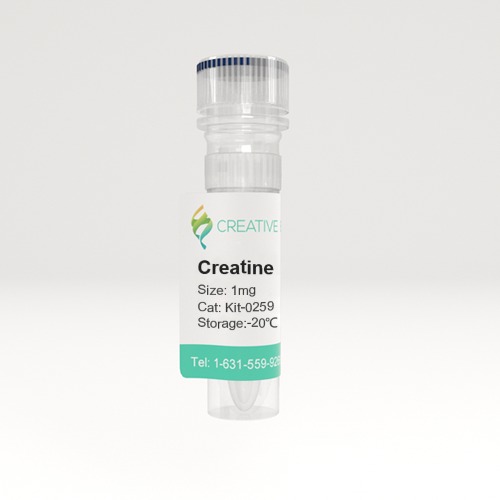

🧪 Kit-0816
Source:
Species:
Tag: Non
Conjugation:
Protein Length:
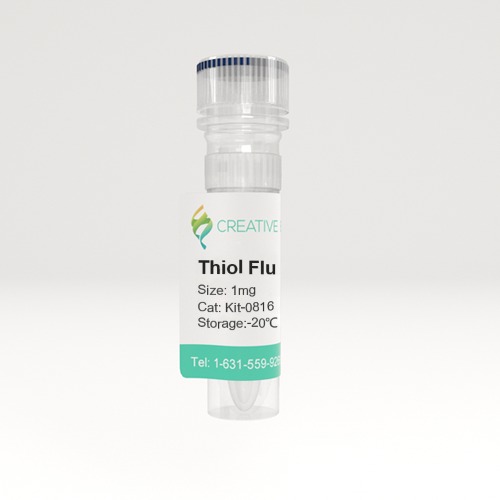
Background
Overview
The Detection Kits were developed to meet the need for the detection of specific biomarkers in clinical diagnosis and biomedical research. These kits are capable of providing real-time, non-invasive and continuous monitoring of physiological parameters and have important clinical implications for health management and disease treatment. In order to improve the sensitivity and specificity of the Detection Kits, various techniques are employed, such as the fluorescence probe qPCR principle and the CGE-LIF method, which combines capillary electrophoresis and sensitive laser-induced fluorescence.
The Detection of host cell residual DNA in biological products is an important part of quality control, so the development of Detection Kits is also driven by regulations and standards. For example, WHO and FDA have put forward requirements for monitoring and control of exogenous host DNA residues in biological products to ensure the safety and quality control of biological products. With the advancement of science and technology, Detection Kits continue to integrate the latest research results in the fields of new materials, bioengineering and molecular biology. For example, the development of flexible electrochemical sensors utilizes highly reactive porous materials and metal oxide films to improve the sensitivity and accuracy of detection
Development Course
The development of Detection Kits reflects the progress of science and technology in the field of biomedical research and clinical diagnosis. In the early days, Detection Kits relied heavily on traditional biochemical methods such as enzyme-linked immunosorbent assay (ELISA) and immunofluorescence techniques. These methods, while effective, usually require a long time and complex operating steps. As the technology evolved, Detection Kits began to incorporate more automation elements. For example, a full-process machine chemist platform that integrates mobile robots, chemical workstations, intelligent operating systems, and scientific databases enables full-process development of chemical synthesis-characterization-testing.
In the context of intelligence and data-driven, Detection Kits begin to leverage big data and intelligent models to optimize inspection processes. These kits are able to read literature through machine intelligence, extract expert experience from massive data, and develop experimental protocols. In order to meet the needs of high throughput screening, Detection Kits are also being developed to micro-scale. For example, using microfluidic technology and nanotechnology, kits are able to perform highly sensitive tests in tiny sample sizes.
The development of Detection Kits is also reflected in the cross-integration of multi-disciplinary technologies. For example, combining knowledge from fields such as materials science, bioengineering, and computer science has led to the development of highly sensitive and specific detection methods. In the future, Detection Kits is expected to focus more on the needs of personalized medicine and precision medicine, developing more customized detection solutions for specific diseases and patient groups. At the same time, with the continuous advancement of artificial intelligence and machine learning technology, Detection Kits may enable more advanced data analysis and interpretation capabilities, further improving the accuracy and efficiency of detection.

Classification of Kits
RNase Detection Kits (RNase Detection Kits)
RNase Alert Lab Test Kit: Used to detect the presence of RNase contamination in laboratory samples, reading the results by UV light source; RNase Alert QC System: Designed for high-throughput RNase monitoring, quantitative detection using a microplate fluorometer.
ATP Detection Assay Kits
Luminescent ATP Detection Assay Kit: The luminescent ATP detection assay kit is used to measure intracellular ATP levels by generating a light signal from the reaction of luciferase and luciferin.
Enzyme Activity Detection Kits
S-Nitrosylation Western Blot Kit: Used to detect a post-translational modification of protein S-nitrosylation using specific antibodies.
Biotin Binding Protein Detection Kits Biotin Binding Protein Detection Kits
Streptavidin, NeutrAvidin, and Avidin Conjugates: Provide binding proteins for biotin-labeled antibody or protein probe detection, including horseradish peroxidase (HRP), alkaline phosphatase (AP) conjugates, and fluorescent markers.
Applications
RNase Detection (RNase Detection). The RNase Alert Lab Test Kit is designed to detect the presence of RNase contamination in laboratory samples, which is essential to ensure the accuracy of RNA experiments. The kit can perform the test in less than an hour, reading the results from a UV light source to visually show the presence or absence of RNase.
Protein activity detection. Active Rho Sedimentation and Detection kit: It is used to selectively enrich and detect GTP-bound Rho GTPase, which is very important for the study of biological processes such as cell signal transduction and cytoskeletal rearrangement.
Biological product development. In various scenarios such as environmental monitoring and food testing, specific substances such as lactose, urea, uric acid, acetic acid, etc. are determined to achieve quality control.
Case Study
Case Study 1: Creatine Assay Kit (Kit-0259)
Antiphospholipid antibodies (apl) cause severe autoimmune diseases characterized by vascular lesions and pregnancy complications. In this study, we found that endosomal lysodiphosphatidic acid (LBPA), presented by CD1-like endothelial protein C receptor (EPCR), is a pathogenic cell surface antigen that is recognized by apl and induces thrombus formation and endosomal inflammatory signaling. apl binds to EPCR-LBPA expressed on innate immune cells to maintain interferon and Toll-like receptor 7-dependent B1a cell expansion and autoantibody production. Albumin in spot-urine samples was detected with mouse albumin ELISA and normalized to creatinine content with the Creatine Assay Kit.
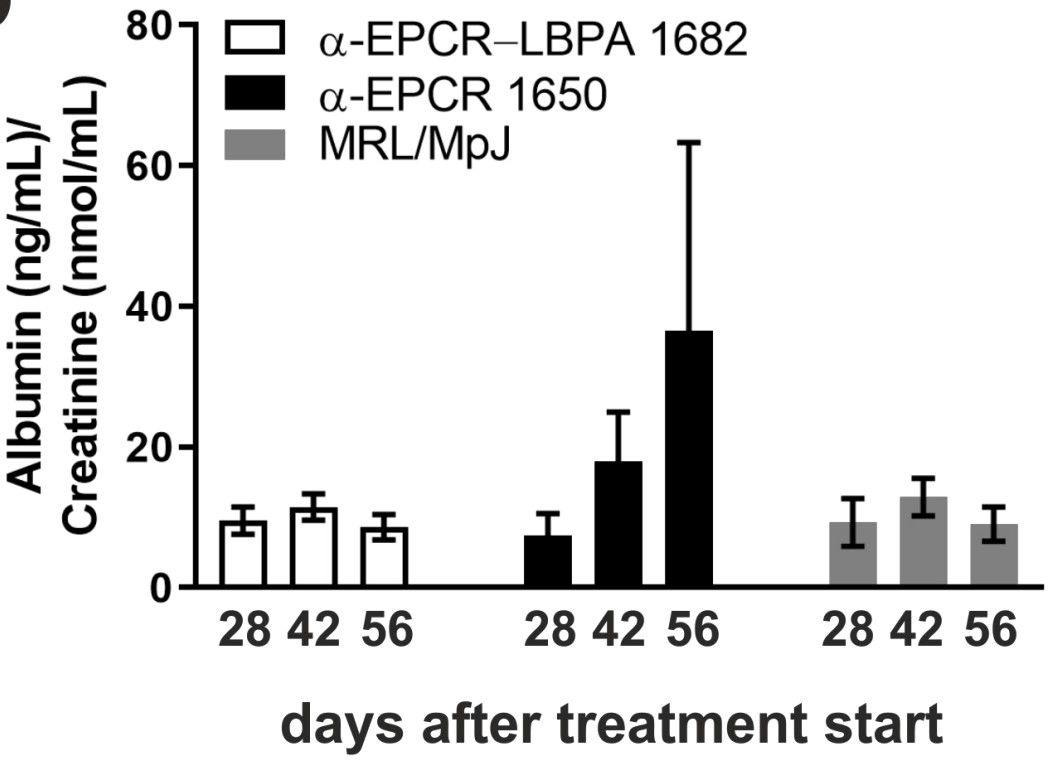
(Nadine Müller-Calleja, 2021)
Fig1. Albuminuria in MRL/MpJ control mice and in MRL-Faslpr mice treated at the age of four weeks for six weeks with the indicated antibodies.
Case Study 2: Thiol Fluorometric Detection Kit (Kit-0816)
In methanogens, one form of gene expression is the expression of copper-regulated alternative forms of methane monooxygenase. A copper-binding compound called methanomycin plays a key role in the absorption of copper by methanoxidation bacteria. Methanobactin is a ribosome synthetic post-translational modified peptide (RiPP) formed by binding the X-Cys dipeptide sequence to copper. The gene encoding methanesin precursor peptides, mbnA, is part of a gene cluster, but the role of other genes in methanesin biosynthesis is unclear. To elucidate the function of these genes, a marker-free deletion of mbnABCMN was constructed in trichosporium Methylosinus OB3b, and then homologous expression of mbnABCM using a wide host range clonal vector was used to determine the function of mbnN, annotated as encoding aminotransferase. The methicotinoid produced by this strain is very different from the wild-type methicotinoid, lacking C-terminal methionine and forming only one of the two oxazolone rings, the results of thiol determination in methanobactin from M. trichosporium OB3b wild-type, ΔmbnAN + pWG101, and ΔmbnAN + pWG102 strains with kits are really different.
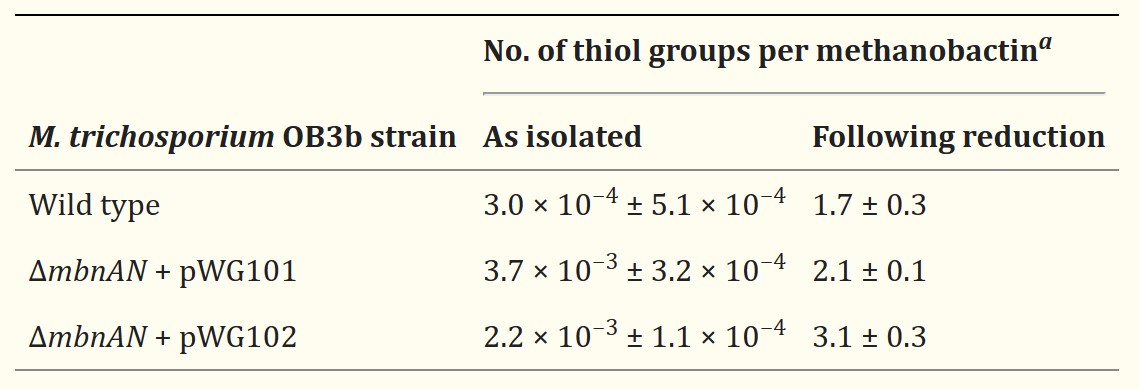
(Wenyu Gu, 2016)
Fig2. Quantification of thiol groups in methanobactin from M. trichosporium OB3b wild-type, ΔmbnAN + pWG101, and ΔmbnAN + pWG102 strains as isolated and following reduction by tris(2-carboxyethyl)phosphine under anaerobic conditions.
Case Study 3: Uric Acid Assay Kit
The main aim of the present study was to investigate the biological function of uric acid. The level of uric acid in different organs in normal male rats was determined with uric acid assay kits, and the expression level of genes in the organs was determined by RNA quantitative sequencing. The correlation analysis between uric acid in the organs and gene expression (measured by FPKM value) was made. Serum uric acid (SUA) in patients with breast cancer or with breast benign tumor was assayed when the diagnosis was made, and SUA in patients with breast cancer was also assayed just after chemotherapy. There were 1937 mRNAs whose expression level significantly correlated with the level of uric acid, and most of which were associated with purine or nucleoside metabolism, cellular metabolism, cell cycles, and cell death pathways. Further analysis showed that the level of uric acid was highly correlated with cell death rather than cell viability. The level of SUA in patients with breast cancer was higher than that in patients with breast benign tumor, and the SUA increased after chemotherapy.
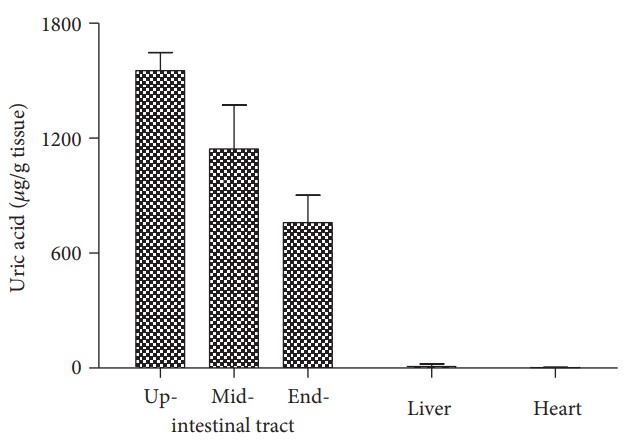
(Dequan Liu, 2019)
Fig3. Distribution of uric acid in neonatal rats.
Advantages
- Product diversity. This series of kits is a collection of various functional kits that provide the detection of metabolites, biological structural substances, enzymes and other substances.
- Technical specialization. Our R&D team are dedicated to developing all kinds of test kits. They have a rich academic background ranging from Molecular biology, Pharmacy to Cell biology, Medicine.
- Customized service. We not only provide standardized test kits, but also provide customized test kits according to customer needs. The flexibility of this service can better meet specific research needs and provide customers with more personalized solutions.
Creative BioMart offers a series of Detection Kits including a variety of kits for detecting specific biomarkers, pathogens, genetic variants, and more. You can also let us know if you have any customized requirements. Please contact us for more product details.
References
- Müller-Calleja N.; et al. Lipid presentation by the protein C receptor links coagulation with autoimmunity. Science. 2021;371(6534):eabc0956.
- Gu W.; et al. An Aminotransferase Is Responsible for the Deamination of the N-Terminal Leucine and Required for Formation of Oxazolone Ring A in Methanobactin of Methylosinus trichosporium OB3b. Appl Environ Microbiol. 2016;83(1):e02619-16.
- Liu D.; et al. What Is the Biological Function of Uric Acid? An Antioxidant for Neural Protection or a Biomarker for Cell Death. Dis Markers. 2019;2019:4081962.













